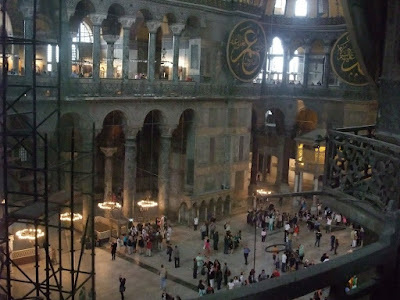I had a date in Constantinople, but she was waiting in Istanbul.
As you may recall from the song, Istanbul was not always so named. Actually, the etymology of Istanbul goes even further back than that. Originally, the city was a Greek city called Byzantium, chosen for its advantageous location on the Bosphorus Strait, named for its founder, Byzas. When the Roman Empire overtook the failing Greek empire, the Emperor Constantine quickly realized how strategically Byzantium was located, and chose to center his newly founded Holy Roman Empire around the city. Naturally, Constantine changed the name from the original Greek, and the city was named after its new emperor – Constantinople. When the Roman Empire fell, the Ottoman Empire claimed the city and, unsurprisingly, didn’t want their new capital city named after a Roman Emperor. Instead, they changed the city’s name once more to Istanbul. The fact that Istanbul has been at the center of three empires (Greek, Roman, and Ottoman/Turkish) means that there is a huge diversity of architecture, monuments, and sights, so prepare yourself for some pretty neat sights.
One question that soon presented itself in my mind is why Istanbul, which is the economic, cultural, and historical capital of Turkey, in addition to its largest city, is no longer the political capital. It turns out that Atatürk, the founder of modern Turkey, overthrew the government that was centered in Istanbul in the 1920s and had to organize his subversive activities far outside the capital. So where did he organize this rebellion? You guessed it! (But not really). Ankara! Atatürk centered his government around Ankara, and it has remained the capital of Turkey ever since.
Alright, enough Turkish history, and onward to the fabulous adventures of Katie in Istanbul!
Here is one of the first sights I saw in Istanbul. It is an Egyptian obelisk that is Really Old (about 3000 years, I think) that some emperor or another ordered moved to Byzantium or Constantinople or Istanbul from Egypt. It probably has some historical significance other than that, but I seem to have forgotten it. Oops.
Also, it wasn’t actually slanted. That’s just bad photography on the part of Yours Truly.
Next, we walked about 300 meters to the rather imposing Blue Mosque, which is shown in a somewhat truncated photograph above. The Blue Mosque was apparently built by a Muslim emperor in the 17th century who wanted to rival the famous Haga Sophia church, which is shown a few paragraphs on (this is a chronological tour, so no complaints!). There is a funny story associated with the Blue Mosque – apparently most minarets have one, two, or sometimes four minarets, but the Blue Mosque has six. According to our tour guide, the emperor told the chief architect that he wanted a mosque with gold minarets. The architect, however, knew that the common people would all steal the gold off of the minarets, and the mosque would be destroyed within months. The architect craftily noticed that the word “gold” and “six” are almost identical in Turkish, so he instead designed a mosque with six minarets. When the emperor complained to him, the architect claimed that he had misheard, and thought that the emperor wanted a mosque with six minarets! What a clever clogs.
This is a picture of the interior of the Blue Mosque. The entire interior is made of mosaics. Impressive, no?
Next, we came to Hagia Sophia, the church that the Blue Mosque was built to best. Hagia Sophia’s exterior looks like a slightly smaller version of the Blue Mosque. What makes it truly amazing, however, is its age – Haga Sophia was built in the 6th century AD, and has remained intact ever since. Although it was originally a churich, it was later converted to a mosque, and finally to a museum (which it remains today).
This is the interior of Hagia Sophia – the place was blinking enormous!
Here is one of the many murals covering the walls of Hagia Sophia. At one point, they were covered over by Islamic murals, but the murals were removed when Hagia Sophia became a museum.
This building is very historically important. I can’t remember why, but I have enough pictures of it that I know it merits some sort of explanation. I am sorry to fail you, dear reader, but I have no explanation to offer.
Our final stop in Istanbul was the famed Turkish bazaar, the largest indoor bazaar in the world. I have been to a number of markets all over the world – everywhere from Quincy Market in Boston to Chinese, Cambodian, and Thai markets, and the Istanbul market was one of the nicest I have ever been to. Not only was the area very clean, but the venders themselves were very kind and were genuinely helpful. I was pleasantly surprised by how easy and pleasant shopping was here – in parts of China, for example, I often found that I couldn’t even walk past a shop without being practically chased into the street by the shop’s owner trying to sell me something.
A few purchases later, it was sadly time to get back on board the boat and head off for Greece again. I was sad to leave Istanbul, but I’m sure I’ll be back – I’d love to visit Constantinople at some point, and I hear it’s in the area.
Saturday, July 24, 2010
Subscribe to:
Post Comments (Atom)








No comments:
Post a Comment